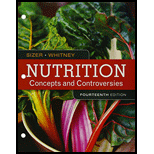
To identify:
Two critical periods of life that demand high nutrient intake and defend the use of the vegetarian diet at this time. Also, discuss the nutrient challenge and the solutions at these stages.
Introduction:
Nutritional requirements vary with different stages of human life. To maintain a healthy life and body function, it is important to intake a nutritious diet that includes adequate protein, carbohydrate, and fat along with essential vitamins and minerals, and fatty acids. Here, we identify the two most crucial period of life that need high nutrient intake. Also, we need to discuss the challenges and solutions related to life stages.
Trending nowThis is a popular solution!

Chapter 6 Solutions
Bundle: Nutrition: Concepts and Controversies, Loose-leaf Version, 14th + MindTap Nutrition, 1 term (6 months) Printed Access Card
- Some nutritionists claim that the secret to long life is to be slightly underweight as an adult. If a persons weight is related partly to diet, partly to activity level, and partly to genetics, what underlying factors could be at work to generate statistics that support this claim?arrow_forwardDiscuss why obesity is a growing epidemic.arrow_forwardWhich of the following statements is not true? a. Essential nutrients can be synthesized by the body. b. Vitamins are required in small quantities for bodily function. c. Some amino acids can be synthesized by the body, while others need to be obtained from diet. d. Vitamins come in two categories: fat-soluble and water-soluble.arrow_forward
- When a child has a chronic condition that limits activity, such as spina bifida, what is the greatest long-term nutrition concern? a. Protein limiting growth b. Modified food textures to avoid eating difficulties c. Excessive calorie intake further limiting mobility d. Intake of calcium and vitamin D to prevent bone fracturesarrow_forwardThe preferred energy sources for the body are ________.arrow_forward
- Health Safety And Nutrition F/Young ChildHealth & NutritionISBN:9781305144767Author:MAROTZPublisher:Cengage
 Human Physiology: From Cells to Systems (MindTap ...BiologyISBN:9781285866932Author:Lauralee SherwoodPublisher:Cengage Learning
Human Physiology: From Cells to Systems (MindTap ...BiologyISBN:9781285866932Author:Lauralee SherwoodPublisher:Cengage Learning Nutrition Through The Life CycleHealth & NutritionISBN:9781337919333Author:Brown, Judith E.Publisher:Cengage Learning,
Nutrition Through The Life CycleHealth & NutritionISBN:9781337919333Author:Brown, Judith E.Publisher:Cengage Learning, Human Biology (MindTap Course List)BiologyISBN:9781305112100Author:Cecie Starr, Beverly McMillanPublisher:Cengage Learning
Human Biology (MindTap Course List)BiologyISBN:9781305112100Author:Cecie Starr, Beverly McMillanPublisher:Cengage Learning





